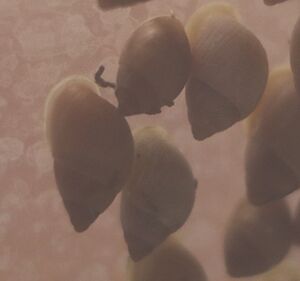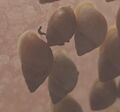Partula mooreana facts for kids
Quick facts for kids Moorean viviparous tree snail |
|
|---|---|
 |
|
| Conservation status | |
| Scientific classification |
The Moorean viviparous tree snail, known scientifically as Partula mooreana, is a type of air-breathing land snail. It's a small mollusk that lives on land, belonging to the Partulidae family. These snails used to live only on the island of Moorea in French Polynesia. Sadly, this species is now extinct in the wild, meaning it no longer exists in its natural home.
Contents
What is the Moorean Viviparous Tree Snail?
The Moorean viviparous tree snail is a fascinating creature. It's called a "tree snail" because it lives in trees and bushes. The word "viviparous" means that, unlike most snails that lay eggs, these snails give birth to live young. This is a special way of reproducing for snails.
Physical Features of the Snail
These snails have a shell that is usually pale yellowish-horn color. Sometimes, their shells have one to three narrow, light brown bands. The top part of the shell, called the apex, is often a bit darker. The shell has about five turns, or "whorls," which are mostly flat.
The opening of the shell, called the aperture, is about half the length of the entire shell. The edge of this opening, called the lip, is white and slightly turned outwards. Inside the shell, near the opening, there's a small, oval-shaped tooth-like structure.
The shell itself is quite thin and you can see through it a little. Its surface looks smooth but has tiny lines and patterns when you look closely.
Where Did These Snails Live?
The Moorean viviparous tree snail was endemic to the island of Moorea in French Polynesia. This means it was found nowhere else in the world naturally. They lived in the Vaianai Valley on Moorea, often found on bushes.
Why Are These Snails Important?
Partula snails, including Partula mooreana, are very important for understanding how species change over time. Scientists have studied them for many years because they show interesting differences even within the same species.
Conservation Status: Extinct in the Wild
Sadly, the Moorean viviparous tree snail is now extinct in the wild. This means that while there might be some snails of this species living in zoos or special breeding programs, they no longer exist in their natural habitat. This happened mainly because of invasive species, especially a predatory snail called Euglandina rosea, which was introduced to control another snail species.
Images for kids



